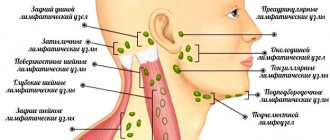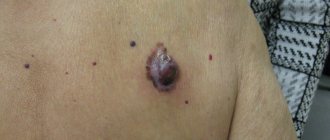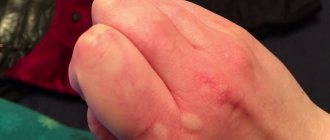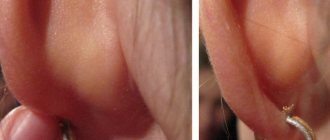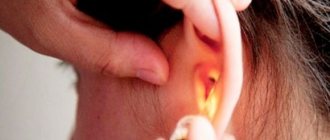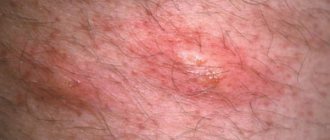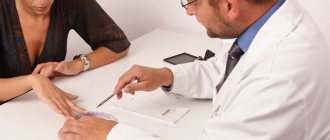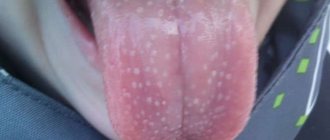What is erythroderma
When characteristic symptoms appear on the skin, which can occur in the form of itching, redness, swelling or peeling, there is a possibility of developing erythroderma. This disease immediately covers large areas of the epidermis, so a sharp increase in the number of flaky segments on the body is the norm even in the early stages of the disease.
Some people do not know that this is not a specific skin disease, but a general name for several forms of pathological processes. Symptoms may occur differently in each patient, everything will depend on the initial state of health of the patient. Very often, an illness of this kind becomes chronic, slowing down the progress of treatment. The most important factor underlying the appearance of this disease is the complication of eczema.
Who is diagnosed with psoriatic erythroderma?
Psoriatic erythema is rarely diagnosed - in only 1-2% of people with psoriasis. A greater percentage of incidence occurs in the male population aged 50 years and above. In women, the pathology also occurs, but much less frequently, almost 2 times.
Photo of psoriatic erythroderma
The aggravation occurs in autumn and spring. Severe symptoms require urgent hospitalization due to the high probability of intoxication of the body, which poses a danger to the health and life of the patient.
Psoriatic erythroderma develops due to the complete loss of the protective functions of the skin. Infectious and immunological pathologies can lead to the disease. Often the source of erythroderma cannot be determined. Such forms are called idiopathic in medicine.
In addition, the cause of the disease can be medications, but to a greater extent, erythroderma is provoked by skin pathologies (most often it is pustular psoriasis).
Attention! Psoriatic erythroderma, with improper and untimely treatment, often develops into mycosis fungoides, which is characterized by malignant skin lesions.
Symptoms of erythroderma
The disease has multifaceted manifestations that can develop in several ways. However, the disease is identified based on the characteristic symptoms of erythroderma, one of which is flaky areas of skin on the back, chest, upper or lower extremities. In addition, patients experience problems with hair and nails due to general fatigue. Increased sweating is also a sure sign of complications in the body.
Patients often suffer from vasodilation, they are tormented by chills, high fever and constant itching of the skin. In some severe cases, swelling of the extremities may occur - this sign signals a deterioration in the patient's condition. Rash, irritation or rashes are one of the first symptoms of the disease, which help highlight the pathology and signal the need for treatment.
Symptoms of erythrodermic psoriasis
Common to both types of erythroderma are epidemic (skin) manifestations that can be located on any part of the body, including the head (under the hair):
- bright red pigmentation;
- loosened cells of the stratum corneum of the skin (scales), torn away from the body;
- swelling;
- hyperthermia of the affected areas;
- the presence of compactions (infiltrates) under the skin;
- sensation of itching, tightness, burning, epidermis.
Small affected areas quickly grow, combining into large red spots. In the photo, psoriatic erythroderma looks like a flaky layer of dead epidermis, whitish in color, which resembles a shell.
The skin under the fallen scales becomes wet and may bleed. The ingress of any pathogenic microorganisms leads to severe infections with a purulent course.
The generalized type is characterized by gradual development with increasing symptoms and enlarged lymph nodes.
With the hyperergic type, the disease develops in an accelerated mode, and is accompanied by the following symptoms:
- febrile (38-39 °C) or perethic (39-41 °C) temperature;
- headaches, soreness in muscles and joints;
- hyperhidrosis (excessive sweating);
- symptoms of intoxication (nausea, vomiting, weakness).
Contact with clothing of the skin causes irritation and pain. Having spread throughout the body, the rash spreads to the mucous membranes of the mouth and tongue. In the presence of concomitant diseases, their symptoms worsen. The patient's condition is rapidly deteriorating.
Causes of erythroderma
A separate block in the process of treating any disease is the identification of cause-and-effect relationships. Until now, doctors have not figured out what factors can contribute to the development of the primary type of the disease, however, the secondary causes of erythroderma are well known in medical circles. These include certain diseases, the transmission of which leads to disorder of the body and an increase in the likelihood of pathology. The disease can be caused by:
- scalded skin syndrome;
- toxicoderma;
- lymphomas;
- SLE (systemic lupus erythematosus);
- dermatitis;
- congestive dermatitis;
- diffuse neurodermatitis;
- Lyle's disease;
- colon cancer;
- reticular erythroderma;
- mycoses;
- seborrheic dermatitis;
- HIV;
- pruritic scabies;
- ichthyosiform dermatoses;
- Reiter's syndrome;
- leukemia;
- pustular skin disease;
- lichen planus;
- fungal diseases;
- scaly lichen;
- thoracic cancer;
- solitary myeloma;
- tinea capitis;
- exfoliative pemphigus.
Erythroderma - a signal from the body about skin problems
Erythroderma is a condition of the skin in which it is completely or almost completely affected.
The key symptoms accompanying this disease are very characteristic: the surface of the skin becomes red, peeling, and constant itching are observed.
The disease, quite often, “fixes itself” in the body for a long time, becoming chronic.
There are plenty of factors contributing to the development of the disease, but in most cases, dermatologists recognize a complication (severe form) of eczema as the main, fundamental cause.
General information about erythroderma
This skin pathology is more common in men whose age has crossed the forty years mark. Among other skin diseases, erythroderma in percentage terms is extremely rare, no more than 2%. We can classify three features that are very characteristic of such a disease:
- the area of the damaging effect can be considered close to absolute (almost all areas of the skin are affected)
- systematic peeling that does not stop even in the later stages of the disease
- extremely difficult to treat
The main classification of the disease involves two key forms:
- primary, the occurrence of which is possible without any reason, at least visible
- secondary - resulting from existing skin diseases, and not only diseases, the list of which is quite extensive, here are just a few (psoriasis, various types of dermatitis, blood leukemia, colon cancer, lung cancer, fungal diseases)
Erythroderma is characterized by both acute and chronic course. As for the acute form, in most cases, this is an allergic response of the sick person’s body to various types of medications.
Chronic, most often resulting from the presence of any general ailments, for example, mycosis, leukemia.
Symptoms of erythroderma
The symptoms of the disease are very multifaceted, let's highlight the most basic signs:
- significant increase in body temperature
- significant deterioration in the general condition of the victim
- baldness
- serious problems with the nail plates
- increased heat transfer, which is caused by greater sweat production, an increase (expansion) of skin vessels located on the surface
- the patient is constantly cold, this feeling is especially intensified by chills
- You may experience a feeling of “dry skin”
- itching, burning
- against the background of heart failure, there is a possibility of edema occurring, although such a scenario is completely negative, if the situation worsens
In the later stages of the disease, the symptoms listed above may well be joined by tachycardia, an increase in the size of the spleen and liver.
Types of erythroderma
In view of the wide variety of different types of this disease, of course, we will not be able to dwell on all of them, but the two, perhaps the most “popular” ones, are worth mentioning in more detail.
1. The causative circumstances for the emergence and further development of psoriatic erythroderma can be considered:
- extremely aggressive irradiation of the skin surface with sunlight
- systematic stressful, neuro-emotional shocks
- unskilled approach to the therapeutic process (taking irritating drugs)
It is strongly recommended that the treatment process be carried out with the direct participation, or at least under the strict supervision, of an experienced dermatologist.
2. Now a few words about eczematous erythroderma. An excellent prerequisite for the development of this form of the disease is favorable “genetic soil”. However, it is worth noting here that only the prerequisites for various manifestations of the disease, but not the disease itself, can be transmitted through the “family channel”.
Please note that the likelihood of developing eczema has a direct relationship with a person’s lifestyle and how closely it can be called healthy.
Factors that provoke the appearance of eczema include: various addictions, love relationships with carbohydrates, food products that contain allergens. In addition, this list can be supplemented with unfavorable working conditions.
The main criteria for the treatment process are as follows:
1. A mandatory, primary condition is the accurate diagnosis of the disease that provoked the appearance of erythroderma. The list of medications taken, with the exception of vitally important ones, must be significantly adjusted.
2. It is advisable that the patient be located in a room where key air parameters (temperature, humidity) are regulated. It is necessary that he be alone in it. Of course, this is an overly idealized scenario, but nevertheless, it is better to try to implement it.
As an alternative, the patient may be in a general ward. However, there are quite a lot of requirements that need to be met: constant, several times a day, wet cleaning, regular replacement of bed linen, the possibility of carrying out a systematic quartzing procedure.
3. It is necessary to try to protect the patient, or rather his skin, from contact with water and detergents.
4. A hypoallergenic diet is recommended for consumption.
If the true cause that gave impetus to the development of erythroderma has not been identified, then a standard set of therapeutic measures appropriate for the given situation is indicated for use.
The correct selection of a therapeutic course will be possible only after identifying the initial causes that prompted the disease to develop rapidly.
For example, this may include: exposure to heavy metals, poisoning of the body, problems with the immune system, malignant processes.
As noted above, the list of possible prescribed medications is quite extensive, but the main groups of drugs prescribed by dermatologists include:
- enterosorbents - help remove harmful, toxic substances and allergens from the body
- antihistamines - minimize the nagging sensation of itching
In especially severe cases, hormonal drugs are added to the prescriptions.
It is especially important that the treatment process is carried out in the appropriate specialized department of a medical institution, since only in such conditions is it possible to receive the necessary therapeutic procedures in full.
Any skin lesion, including erythroderma , is a loud and stable “sos” signal about existing troubles within the body. Usually, these are hidden problems in the functioning of the gastrointestinal tract. Therefore, to try to avoid such problems, you should pay close attention to the health of your skin.
Take an interest in your health in a timely manner, goodbye.
Source: https://life5plus.ru/domashnij-doktor/kozhnye-zabolevaniya/eritrodermiya.html
Classification of erythroderma
Partial or complete lesions of the skin in dermatology are usually classified as a separate method of classifying erythroderma, among which primary, secondary and idiopathic are distinguished. The first type occurs suddenly, without any additional external signals and has two forms of development - acute and chronic. The acute type of the disease in most cases is a response to a provoking factor, for example, drug intolerance.
The chronic form of the disease can be either congenital or acquired. When the disease appears immediately after birth, the pathology is difficult to treat and requires a longer period of therapy. Acquired complications are considered to be a consequence of leukemia. Secondary erythroderma occurs when suffering from severe skin dermatoses such as psoriasis, dermatitis or eczema. The idiopathic form of the disease develops in older people; it is possible to establish the cause of its occurrence in very rare cases.
Psoriatic
This type of psoriasis is chronic and is considered one of the most dangerous skin diseases. Due to the widespread pathological effects, psoriatic erythroderma affects the entire body in a matter of weeks, causing patients to suffer from discomfort. The disease requires urgent medical intervention, since psoriasis can only be diagnosed clinically. There are three forms of this disease: suppurating, generalized and hyperergic.
A characteristic sign of generalized erythroderma is complete skin lesions. The first element of the process is scaly plaques of bright red color (edematous erythema). With the hyperergic form of the disease, single foci of inflammation will be observed throughout the body, they are accompanied by a burning sensation or itching. Suppurating erythroderma leads to the formation of pustular rashes that join the suppurating segments on the body.
Ichthyosiform
Inflammation of the skin with total damage to the epidermis, in which the human body is covered with blistering rashes or neoplasms in the form of large scales, is called ichthyosiform erythroderma. Externally, the peeling resembles mica and is localized around the joints or in the armpits. Genetic dermatoses are diagnosed clinically, sometimes using anamnesis.
The disease can be defined as a congenital pathology or a symptom that foreshadows the development of negative processes in the body. As the disease progresses, the keratinization of the skin is disrupted, and foci of inflammation become noticeable. Dermatosis occurs due to a genetic mutation at birth. There are more than thirty varieties of the disease.
- Sugaring - what kind of procedure is it? How to properly do sugar depilation at home
- Why do jars of cucumbers explode?
- Nettle decoction for hair - recipes
Broca's erythroderma
When the upper layers of the epidermis are affected, most patients suffering from Broca's erythroderma develop characteristic areas of inflammation on the skin. They can appear not only in the form of rashes, but also in the form of scaly formations. This form of the disease is very difficult to treat, and today there is no accurate information about its prevalence. It is known that the disease does not have gender preferences, so the complication manifests itself equally in both sexes.
Leiner's erythroderma
It has not yet been possible to establish the cause of Leiner's erythroderma; doctors' opinions on this issue are divided. Some experts argue that desquamative disease is caused by autointoxication of the body, others are sure that it is a consequence of autosensitization. There is a third point of view, according to which Leiner’s disease affects the blood due to hypovitaminosis.
Lack of timely treatment increases the likelihood of death, so treatment should be started immediately. Taking antibiotics and other medications can improve the prognosis. The disease progresses in case of insufficient nutrition in a newborn child for several months, after which dermatitis enters the active stage.
Varieties
Erythroderma develops in humans in several variants. The types are described based on the disease against which the problem arose. Let's look at the features and signs of common types of the disease.
Psoriatic
Erythroderma accompanies severe forms of psoriasis, when plaque lesions affect a large part of the body.
Special factors play a role in its development: aggressive exposure of the skin to sunlight and unqualified prescription of medications in the treatment of the provoking disease (irritants).
Ichthyosiform
A genetically determined congenital condition, the peculiarity of which is a violation of the process of keratinization of the skin. For the first time in history, the phenomenon was described by Chinese doctors back in the third century BC. Dry forms of the disease are accompanied by:
- feeling of skin tightness,
- the formation of multiple scales no more than a centimeter in size,
- high risk of secondary infection due to a decrease in the protective function of tissues.
Broca's erythroderma
A type of ichthyosis: the predominant state is hyperkeratosis and the absence of a rash. Due to the characteristic appearance of patients, the pathology is often called “fish scale disease.” Its causes are a genetic disorder, due to which dry scales form on the epidermis over the entire surface of the body.
Leiner's erythroderma
The problem develops in children in the first month of life and represents the formation of large-scale rashes originating from the genitals and scalp. The lesions are edematous, protrude above the surface of intact tissues, and weeping phenomena are observed in large folds. Occurs at normal body temperature.
Diagnosis of erythroderma
Such diseases are very difficult to identify. To determine the type of pathology, doctors need to conduct a detailed examination of the patient, which necessarily includes an anamnesis or a blood test. In parallel, during the diagnosis of erythroderma, the dermatological status and condition of the lymph nodes are checked, and the results of the biopsy are studied.
In the absence of accurate forecasts, this may be an indication for additional procedures. These include x-rays, computed tomography, ultrasound and other diagnostic studies. If the cause of the disease was allergens or junk food, then a biochemical blood test is used to identify this type of erythroderma.
Treatment of erythroderma
To eliminate this disease, doctors use complex therapy. Treatment of erythroderma is aimed at eliminating the underlying ailment underlying the development of the skin disease. While undergoing therapy, patients are prohibited from taking medications or other medications that they used before the onset of the disease. They may contain hazardous substances or allergens that cause a pathological process.
The patient must be allocated a separate room with the ability to regulate the microclimate, otherwise the room must be cleaned daily. The main emphasis in treatment is on the use of detoxicants; sodium thiosulfate is additionally prescribed (intravenously). To maintain immunity during illness, patients adhere to a special diet while simultaneously taking medications such as corticosteroids.
Why is it developing?
There is no need to talk about the exact reasons for the development of pathology, since medicine still knows little about them. Today, psoriatic erythroderma is called a disease that appears due to the influence of immune, genetic and environmental factors. In rare cases, there is a connection with heredity (that is, if someone in the family has psoriasis).
Often the pathological process is observed in people with plaque psoriasis (lichen vulgaris). In addition, psoriatic erythroderma is diagnosed in those who suffer from scabies, hypersensitivity to drugs, photodermatitis, spongiosis (exudative inflammation of the epidermis).
The main provocateurs of the disease are:
- Adverse habits;
- Emotional overload;
- Regular and uncontrolled use of medications;
- Weakening of the body's protective functions;
- Abrupt cessation of taking hormonal and antitumor drugs;
- Autointoxication (poisoning of the body with poisons that it itself produces);
- Sunburn;
- Skin injury.
Reference: psoriatic erythroderma develops due to malnutrition in the epidermis and spasm of regional small arteries. The skin is no longer able to protect itself and becomes vulnerable to penetration by pathogenic microorganisms.
When this happens, an inflammatory process (chronic) develops, accompanied by an autoimmune conflict.
This process promotes increased cell reproduction (the rate of cell division in this case becomes almost 200 times greater). Since nutrition is disrupted in this area of the dermis, new cells die very quickly. At this stage, a spot with hyperemia and plaques form.
Related article:
How to take ASD for psoriasis?
The chronic course in this case is easily explained. Violation of the protective function of the epidermis in combination with vascular spasm causes the penetration of pathogenic microorganisms into the skin. And again the inflammatory process develops, the immune response turns on, and the cells begin to multiply. The pathological process is repeated again and again and resembles a “chain reaction”.
Attention! Each time, the condition of the adrenal glands, which take an active part in the production of hormones that fight inflammation, worsens.
